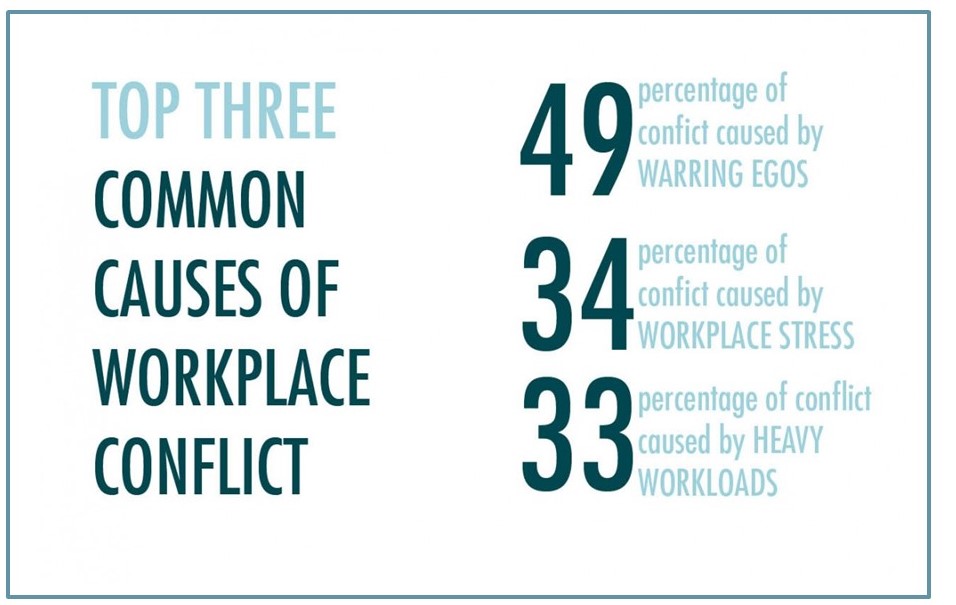If left unchecked, workplace conflict can become a costly problem for your business. It has the potential to not only damage employee morale but also disrupts operations and decreases productivity.
That’s why it’s crucial to handle employee disputes quickly and effectively so they don’t affect your bottom line.
In this article, we will look at the different ways managers and directors can facilitate conflict resolution between two parties within the workplace. We’ll primarily focus on using mediation as a tool to allow both parties to explain their frustrations and bring resolution to the conflict.
With that said, here are the specific steps needed to perform successful mediation.
1. Understand Why the Conflict Has Occurred
The first step to successful conflict resolution is to understand exactly why the conflict has occurred in the first place.
There are a lot of different reasons for conflict, and some conflicts are much more severe than others. For example, a simple disagreement about which podcast hosting platform the company should switch to might bring out deeper personality differences that lead to interpersonal conflict requiring mediation.
Such conflicts may be resolved fairly quickly and easily, but there are more severe conflicts that might require longer and more in-depth forms of conflict resolution, especially those involving bullying, offensive language, or behavior that causes another to feel threatened and unsafe in the workplace.
Whatever the case may be, you need to understand exactly where the issue is stemming from before you can proceed with your conflict resolution strategy.
The image below showcases some of the most common causes of conflict in the workplace:
It helps if you have an open-door policy so you can catch conflicts early.
By creating an environment of open communication, employees will feel a lot more comfortable bringing their concerns to you which allows you to handle them before they become more serious issues.
Make sure your employees understand that they can bring any matter to you without fear of incurring any repercussions.
Practice active listening and you will be more likely to get to the heart of why the conflict has occurred.
2. Talk Directly With Each Party Privately If Needed
Once you understand where the problem springs from, you can start to create a plan to handle the conflict before it escalates any further.
Depending on the severity of the situation, you may want to speak to each party privately in order to encourage them to open up further about the matter. You’ll likely get more from the parties involved by speaking to them directly and privately.
Ask questions to determine the nature and root cause of the issue. Find out if it’s a matter of miscommunication, misinterpretation, mismatched personalities, or if it’s something more serious, such as discrimination or harassment.
3. Allow Each Party to Speak to the Other Without Interruption
In addition to speaking to each party directly, it’s also a good idea to allow them to speak to each other, with the assurance that the other party will not be allowed to interrupt.
Do your best to facilitate an open and welcoming conversation where everyone has the chance to have their say without disruptions or interruptions.
This will also help you in your efforts in reaching a complete understanding of what the problem is so you can bridge differing perspectives and ensure that everyone is on the same page moving forward.
So, for example, after you’ve held the bulk of the conversation, you can give each party the opportunity to explain and listen, after which you can then investigate, analyze, and evaluate both sides.
Don’t make assumptions or jump to conclusions. The conflict resolution process is hardly ever quick or easy. You must take the time to repeat the core concepts of the conversation, restate issues, and ask clarifying questions so you can give the parties involved a chance to correct you.
If you find that either of the parties is becoming agitated or that otherwise productive conversations keep ending in arguments, then you might need to take a break or find a way to help the upset parties clear their minds.
Simple breathing techniques or learning to ask questions instead of immediately responding can be great to help everyone remain calm and centered during the conflict mediation process.
4. Help Both Parties Clearly Identify Points of Agreement
This is an important step in resolving disputes in the workplace. You must find common ground so you can help both parties identify major points of agreement.
Encourage an open discussion between all the people involved in the dispute to make it easier for everyone to understand the other’s interests, what they care about, what the issue is, and so on.
This way, you’ll make it easier to reach a solution and resolve the conflict in a positive way when each party has a better understanding of where the other stands.
5. Discover Why Each Party Feels the Way They Do
In addition to isolating where exactly disagreements are happening, you also need to work to discover why each party feels the way they do, and how they believe resolution can be brought to the conflict.
Make sure everyone involved is clear about what the problem is from the other’s perspective and ask them to explain their own point of view so everyone involved understands exactly what the issues are and how they affect the other party.
Thalita Ferraz from HerBones.com explains, “I’ve had a remote business for some time that mostly involves getting content created. Unfortunately I’ve had many situations where my editor and writers have become frustrated with each other and begun arguing via email. I found that one of the easiest ways to mediate these situations is to schedule a call with both of them and let them discuss it via video chat. This simple adjustment to my managerial approach has led to more production and happier employees”.
6. Allow Both Parties to Express Solutions
The next step is to encourage employees to work out the issue on their own. Allow both parties to express possible solutions to resolve the conflict. This way, you only have to step in if they fail to come up with satisfactory solutions to the issue.
As they discuss, observe and assess and be on hand to ensure that disagreements don’t escalate.
Give employees the opportunity to find common ground on their own and you’ll empower them for the future.
For the most part, employees will find common ground if they are allowed to engage in constructive conversations, and the more disagreements they can resolve on their own, the less you will have to step in whenever there is any office drama, squabbles, or disagreements.
7. Create a Resolution Plan to Check-in At Predetermined Times After the Mediation
Once you’ve come up with a solution that is acceptable to both parties, it’s time to document it and then create a resolution plan so you can check in at predetermined times after the mediation to ensure that no new conflicts have developed.
Make sure you acknowledge the progress made and thank both parties for participating. You can then follow up at a later date using a pre-arranged method.
While, one-on-one meetings in person may be the best option for the initial follow-ups, they may not be required after both parties have found long-lasting resolution to the initial conflict.
To gauge where each part is at, you can use email marketing software your company is already using to send surveys to each of the parties with closed and open-ended questions. You could even use virtual meetings or text-based chat rooms for quick check-ins. If it appears that any problems are still existing, more formalized methods of conflict resolution may be required.
The image below shows that over 85% of employees experience conflict at work.
This means much of a manager’s time is spent dealing with this office discord. But with the strategies outlined above, you’ll have a plan in place to quickly resolve any disputes that arise.
Conclusion
When ignored or neglected, conflict in the workplace can lead to an economic drain and foster feelings of resentment among employees that ultimately ruin productivity.
Fortunately, there are steps you can take to resolve disputes and prevent stagnation that might otherwise affect your bottom line.
Although dealing with conflicts at work is never easy, the tips outlined in this article will help you manage problems in a professional way so you can turn potentially damaging disputes into an educational experience for everyone involved.







Leave A Comment